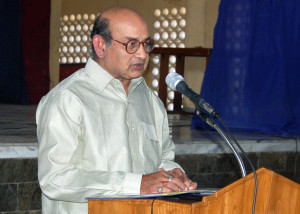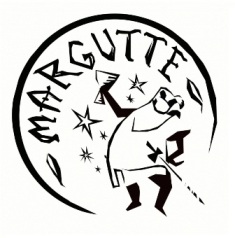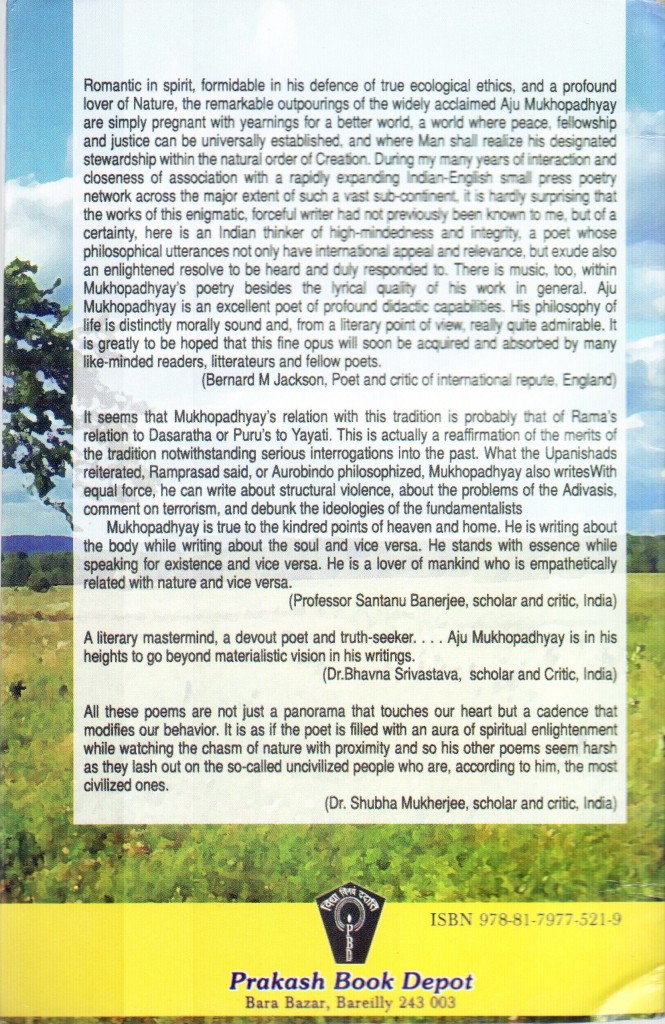 Aju Mukhopadhyay, Pondicherry, is a bilingual award winning poet, author and critic. He has written thirty books and received several poetry awards in India and the USA besides other honours. He has published two volumes of short stories, some of which have appeared in noted anthologies. He has contributed essays on literary and environmental subjects in more than forty scholarly books. A member of many national literary and environmental institutions, he is also published as writer on animals, wildlife, Nature and Environment.
Aju Mukhopadhyay, Pondicherry, is a bilingual award winning poet, author and critic. He has written thirty books and received several poetry awards in India and the USA besides other honours. He has published two volumes of short stories, some of which have appeared in noted anthologies. He has contributed essays on literary and environmental subjects in more than forty scholarly books. A member of many national literary and environmental institutions, he is also published as writer on animals, wildlife, Nature and Environment.
His poems may be broadly categorised in three groups: poems on nature, poems with spiritual overtone and feelings, and poems on social, political subjects. He is one of the noted writers of Haiku and such genres of poetry from India, whose works have been published in many international magazines and e-zines. Quite a few of his poems of Japanese variety have been published in international anthologies and collections. Other poems have appeared in various anthologies, including an Indo-Australian anthology titled Poetic Convention and The Dance of the Peacock, a Canadian Indian venture. He edited some literary magazines in Bangla and is a member of the Editorial Board and Advisory Board of some literary journals.
He has so far published seven books of poems in English and two in Bangla. His eighth volume of poetry is in the press, titled Manhood, Grasshood and Birdhood. He has had the following books published in English: The Witness Tree, In Celebration of Nature, The Paper Boat, Insect’s Nest and Other Poems, Aju Mukhopadhyay’s Poems on Sri Aurobindo and the Mother, Short Verse Vast Universe and Short Verse Delight. The last two are books of Haiku and Tanka, with some essays on the subject of Japanese short verses.
Manhood, Grasshood and Birdhood by Aju Mukhopadhyay – Prakash Book Depot 2014
Excerpts from Author’s Note (edited by Leslie Mcbride Wile)
«Though poetry is not much valued in humdrum society real poetry prevails throughout the ages while many temporary constructions and contemporary castles crumble to ruins.
A poet is known through his poetry. If I am a poet I am known through my poetry seen in the mirrors of true readers and critics. If they find something elevating, educative, artistic or otherwise pleasing in my poetry I would feel grateful to them for reading my poetry, for commenting on them . . .
As an Indian English poet beside my bilingual character, I wish to touch upon literature created by Indians. It seems that Indian English poetry and literature are not favoured much by the common Indian public. It is admitted that many aren’t competent enough to relish but there are some who avoid it or speak against it but it is liked by many educated Indians who realize that in Indian multilingual situation English is getting properly shaped–it is becoming Indian link and literary language; less foreign, less selfish . . .
English has done no wrong. It belongs to India now and is called in its new name, “Indian English.” It is an additional cultural and linguistic resource. All Indian poets and writers who write in this language feel more integrated. The growth of a language and the growth of poets and writers around it are linguistic, cultural and literary phenomena. They have nothing to do with politics. I wish English to prevail and grow with all Indians who may thus claim their seats with the international audience.»
Here are some selected poems.
At the river bank
and quiet flows the river
without a ripple or shiver
trees stand windless
not even a whiff in space
no leaf shakes, no sound;
fishes are sleeping
sweating fishermen around
have lost all zeal
in the act of rowing
their boats stand still
the water shines like a mirror
naked boy looks at his figure;
the world without a name
halts at the bank of the river
no one knows when it came
none, if it was already there.
***
Ant’s Hut
The mother weaver ant
stands silently
in its hut-
the queen is rubbing its chin
with its antennae;
thoughtless for the moment.
Two of its scions are resting
folding their hind legs
stretching their fore legs
drawing their heads inside.
Leafy walls on all sides
leafy roof, leafy floor
look like mud-floored hut,
a lull in the noon, peaceful.
Daughters seek direction, even in rest;
forever workers.
The queen ant sniffs, releases pheromone-
for the move next
they wait.
***
The Grasshood
just few leaves
few stems and seeds
with light body
humble under feet
mowed by machine
neglected like street urchin
but head always high
grass lives and dies and lives
feeds innumerable herbivores
who are food to carnivores;
grass like paddy undulating in moonlight
feeds millions of men and mice
grass like wheat feeds the hungry human tide
grass like bamboo covers large chunks of wood
raising its head high, characteristic of grasshood,
helping elephants rats and men to lead healthy life;
grass grows covering miles and miles
but man reduces its size
killing it with might
telling the earth with perfect satire
that he never wishes
such trifle thing and slight
as grass to interfere
in his high-handedness,
that man can prepare
uprooters, satellites and cutters
poisonous nuclear arsenals
et al to put grass to death;
happy grass never dies
living humbly with the head high
man lives and lives
dying to himself many times
until one day to realize
that grass like earth
and wind and space
and water and fire
and breath
is superior
to man
naturally.
(From Manhood, Grasshood and Birdhood)
***
Structural Violence
Ten proud faces beamed
in the slave media:
World’s richest chairmen of companies-
all worth several billion $
arranged in descending order.
The same media on the same day
while the Sun shines to make hay,
published stories
of the bizarre mud cookies
doing the rounds among the poor kiddies
and others, desperate to stave off hunger in Haiti:
“When my mother does not cook any thing”,
says a poor sibling,
“I eat them 3 times a day.”
Rickety, they die in hundreds
as in Africa, exploited for years, degraded.
In a computerized world
with a technological hype and commercial fair
with explicit understanding among the players
to exclusively exploit the market share,
to speculate in the share market;
degrading the earth, water and sky
enjoying the resources everywhere
the successful ones are always victorious.
Is it not a structural violence
against the naïve, innoce
nt children of the earth?
Shall we offer hurrah to the rich for their mirth?
Beg on behalf of the poor for their munificence?
Does the whole structure not require
overhauling or demolition with fire
to rebuild a new structure for all?
***
The Uncivilised
Uighur, a nomadic pastoral tribe
of Turkish origin in Xinjiang,
find it difficult to survive
squeezed out by the Han Chinese
introduced just for this
as was shifted the Ethnic Chinese
to kill the culture, depopulate, destabilise
the peaceful Tibetan Buddhist race;
this was the technique of red-rebellion
of killing and degrading men by brewing poison
of jealousy, hatred and strife among them.
Creating tourism and villa in the land of Jarawas
leads to the extinction of the aboriginals
for they cannot survive the touch of the civilians.
Wherever minerals, oil or woodland treasures are found
men run to acquire the wealth profound
extinguishing the pristine flora and fauna
and the indigenous people, Nature-bound,
in Amazonian, Peruvian forests, hilly belts in India
in Indonesia, Philippines, Canada and Africa.
Moving into galaxies, to the north and south poles
plundering the reserves of the earth and heaven
men feel victorious but the soil they stand on shifts
for their pollutive role in human lives;
that men become pollutants, we are not surprised
that civilised people are the most uncivilised.
***
What Peace is Like
Peace is like the early rays of the Sun,
slightly auburn, spreading on the eastern sky.
Peace is like the mild setting Sun, sure of its return,
splashing colours on the western sky.
Peace is like the rising full moon, bright in its orb,
from above the rows of giant palm trees.
Peace is like the resting of the elephants
in a sward before the promised sunrise.
Peace is like the birth of an arc-rainbow
after the gale and copious rain.
Peace is like a sleeping pregnant cat
on top of the hay stacked in a burn.
Peace is like the child’s sucking sound
from the round breast of its mother.
Peace is like the deep silence of the wood
pregnant with promises near.
Peace is like the concurrent rain
spreading across the vale and dale.
Peace is like the trustful pacing of the child
holding his father’s finger top with nail.
Peace is love, Peace is smile
Peace is fragrance of the flower.
Peace is faithful surrender to the Divine
Peace is enchanting shower.
Peace has its last resort away from the earthly bower
in the Nirvanic void;
beyond the domain of science, history or logic
even as it baffles the ideas of Freud.
Peace is love, Peace is smile
Let the true Peace spread
Let this not be fragile.
© Aju Mukhopadhyay, 2013



